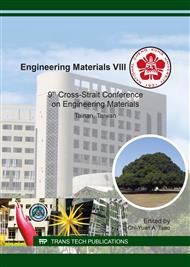[1]
Izumoto R, Ohshima N. Reclaimed rubber and process for reclaiming vulcanized rubber: US, 6335377 B 1[P]. 2002-1-1.
Google Scholar
[2]
Fukumori L et al. Recycling technology of tire rubber[J]. JSAE Review, 2002, (23): 259-264.
DOI: 10.1016/s0389-4304(02)00173-x
Google Scholar
[3]
Kojima M, Ogawa K. Devulcanization of Sulfur-Cured Isoprene Rubber in Supercritical CO2[J]. Rubber Chemical Technology, 2003, 76(4): 957-968.
DOI: 10.5254/1.3547784
Google Scholar
[4]
Tao Guoliang, Ji boyin, Hu yandong, et al. Mechanism of Thermal-Mechanical Shearing Devulcanization of Waste Rubber[J]. Polymer Materials Science & Engineering, 2012, 28 (10): 102-105.
Google Scholar
[5]
Zhao shugao, Zhang Ping, ChangYonghua, et al. Studyon Microwave Devulcanization of Non2polarVulcanizates [J]. China rubber Industry, 1996, 46(5): 292.
Google Scholar
[6]
Zhai junxue, Zhang ping, Zhao shugao. Microwave Devulcanization Machanism of Sulfur-vulcanizate [J]. Special purpose rubber products, 2004, 25(6): 35.
Google Scholar
[7]
Jsayev A, Chen J, Tukachinsky. A novel ultrasonic technology for devulcanization of waste rubber[J]. Rubber Chemistry and Technology, 1995, 68(2): 267.
DOI: 10.5254/1.3538741
Google Scholar
[8]
Achinsky, Schworm D, Isayev A. Devulcanization of waste rubber by powerful ultrasound[J]. Rubber Chemistry and Technology, 1996, 69(1): 92.
DOI: 10.5254/1.3538362
Google Scholar
[9]
Straube G, Straube E, Neumann W. Method for reprocessing scrap rubber[P], USA, US5275948, 1994-1-4.
Google Scholar
[10]
De D, Maiti S, Adhikari B. Reclaiming of rubber by a renewable resource material (RRM). II. Comparative evaluation of reclaiming process of NR vulcanizate by RRM and diallyldisulfide[J]. Journal of applied polymer science, 1999, 73(14): 2951-2958.
DOI: 10.1002/(sici)1097-4628(19990929)73:14<2951::aid-app19>3.0.co;2-b
Google Scholar
[11]
Guoliang Tao, Qianhu He, Yanping Xia, et al. The Effect of Devulcanization Level on Mechanical Properties of reclaimed Rubber by Thermal-Mechanical Shearing Devulcanization[J]. Journal of Applied polymer.
DOI: 10.1002/app.38976
Google Scholar
[12]
Flory P J, Rehner J Jr. Statistical mechanics of cross-linkedpolymer networks(II): Swelling[J]. Journal of Chemical Physics, 1943, 11(11): 521-527.
DOI: 10.1063/1.1723792
Google Scholar


